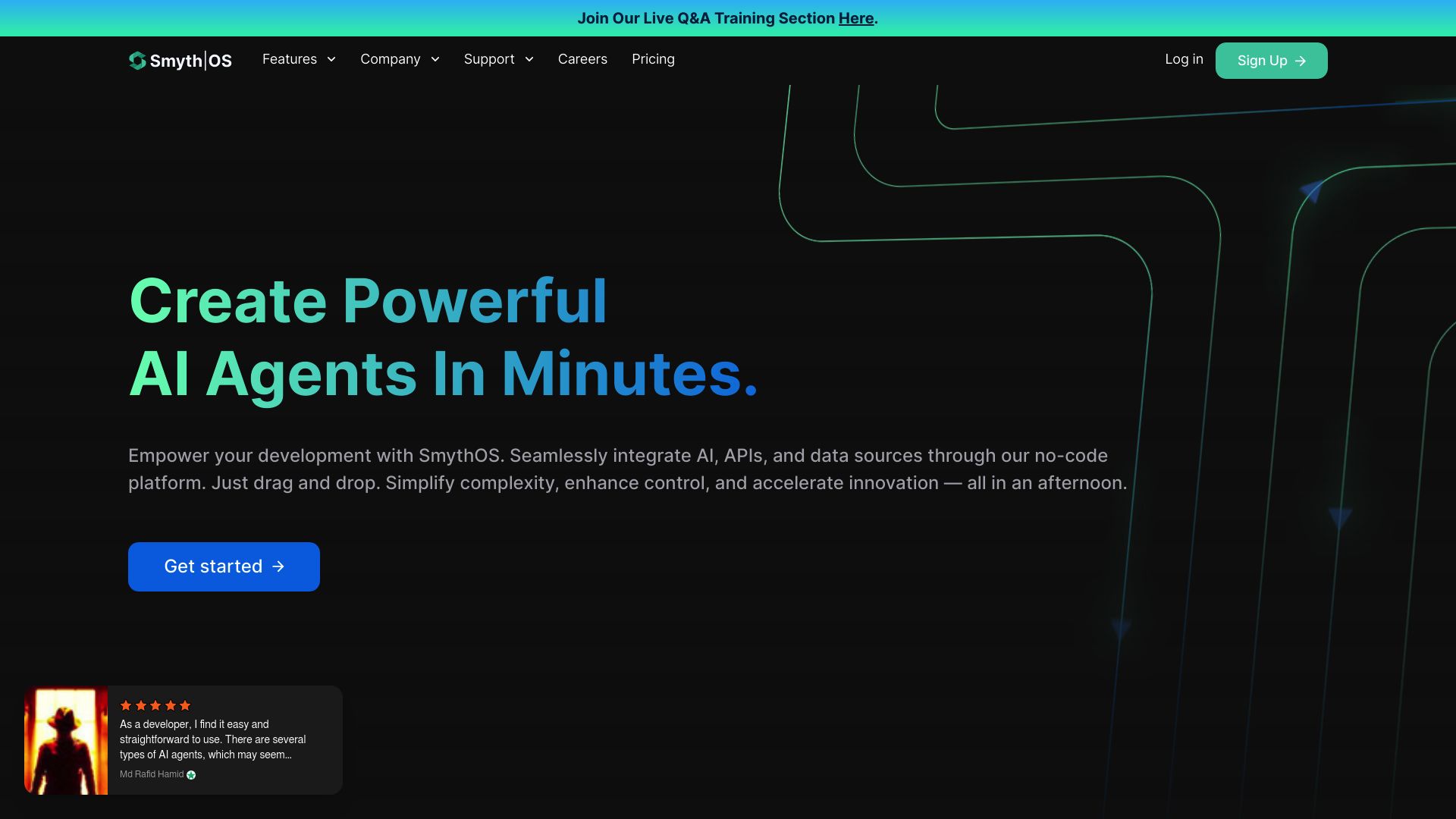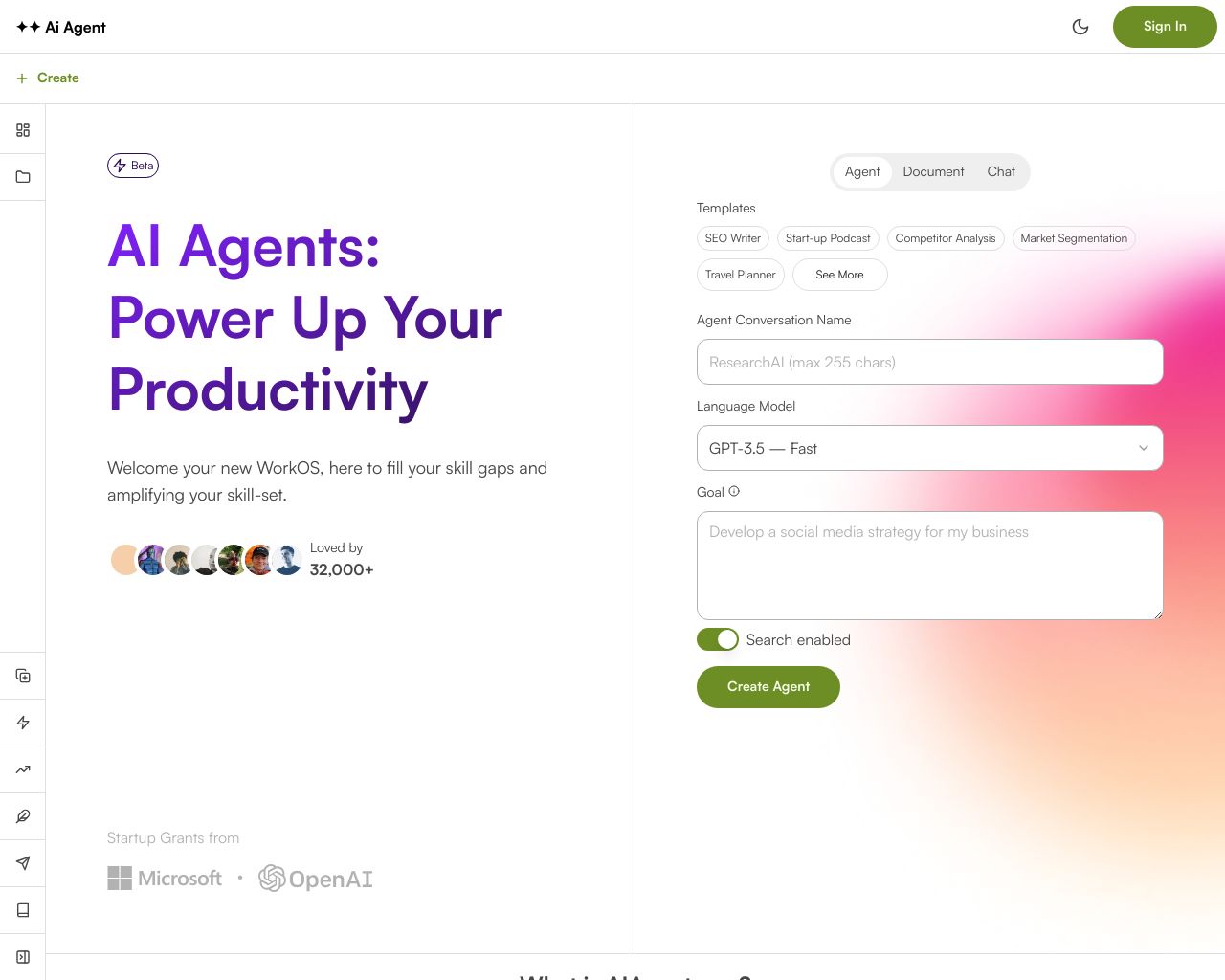AI technology empowers businesses to automate tasks, enhance decision-making, and unlock new possibilities. SmythOS and AI Agent stand at the forefront of this revolution, offering powerful platforms for creating and deploying AI solutions. This comparison delves into the features, capabilities, and ideal use cases for each platform. Whether you’re a developer seeking advanced customization or a business user looking for accessible AI tools, understanding the strengths of SmythOS and AI Agent will help you choose the right solution for your needs. We’ll explore how these platforms tackle key challenges in AI development, from integration and scalability to security and ease of use, providing you with the insights to make an informed decision in your AI journey.
SmythOS Overview
SmythOS revolutionizes AI agent development with its comprehensive platform. Our system empowers users to create, deploy, and manage intelligent agents through an intuitive drag-and-drop interface. SmythOS seamlessly integrates with diverse data sources, APIs, and AI models, enabling rapid deployment of chatbots, applications, APIs, and plugins.


Our platform stands out with its extensive integration ecosystem, supporting a wide range of AI models and tools. We offer pre-built API integrations with popular services like Slack, Trello, GitHub, and Stripe, streamlining workflow automation. SmythOS’s versatility shines in its deployment options, allowing users to launch AI agents across multiple platforms such as Google Vertex, Microsoft Copilot, and Amazon Bedrock.
SmythOS seamlessly integrates with diverse data sources, APIs, and AI models, enabling rapid deployment of chatbots, applications, APIs, and plugins.
SmythOS caters to businesses of all sizes, democratizing AI by making it accessible and user-friendly. Our no-code solution lowers the entry barrier for companies looking to leverage AI, enabling rapid innovation and operational optimization. The platform’s unique orchestration capability combines any AI model, tool, workflow, and data source into a cohesive, scalable, and secure system.
While SmythOS offers a powerful suite of features, users should consider their specific needs when evaluating the platform. Some organizations may require additional customization options or specialized integrations depending on their industry or existing tech stack. However, our comprehensive documentation and support resources help mitigate potential learning curves associated with adopting a new AI development platform.
SmythOS caters to businesses of all sizes, democratizing AI by making it accessible and user-friendly.
SmythOS represents the future of AI-driven automation and collaboration, promising to transform how businesses operate in the digital age. By providing tools to create highly customized and efficient AI-driven solutions, we empower users to stay at the forefront of technological innovation.
AI Agent Overview
AI Agent offers a versatile platform for creating and deploying AI-powered assistants without extensive coding knowledge. Users can build custom agents to automate tasks across 6,000+ integrated apps, streamlining workflows in areas like email management, data analysis, and content creation.
The platform’s visual workflow builder and pre-made templates enable rapid development of AI agents for various use cases, from SEO writing to travel planning. AI Agent emphasizes ease of use, allowing non-technical users to harness advanced AI capabilities through an intuitive interface.
AI Agent offers a versatile platform for creating and deploying AI-powered assistants without extensive coding knowledge.


Key features include customizable agent behaviors, real-time task execution, and support for multiple data sources. The platform offers tiered subscription plans, with varying access to GPT-4, multi-agent capabilities, and support options. This flexibility caters to individual users and businesses seeking to enhance productivity through AI automation.
While AI Agent excels in accessibility, it may have limitations in advanced customization for highly technical users. The platform’s strength lies in its user-friendly approach, extensive integrations, and focus on productivity enhancement for a broad user base. As AI technology evolves, AI Agent continues to expand its capabilities, aiming to democratize access to sophisticated AI tools across industries.
Feature Comparison
SmythOS and AI Agent offer robust platforms for building AI-powered solutions, but key differences set them apart. SmythOS provides a more comprehensive suite of core components, including advanced debug tools, multi-agent collaboration capabilities, and sophisticated memory and context management. These features enable developers to create more complex and autonomous AI systems.
In contrast, AI Agent focuses on simplicity and accessibility, with a user-friendly interface that caters to non-technical users. While this approach democratizes AI development, it may limit the depth of customization available for more advanced use cases.
Security is another area where SmythOS stands out. We offer robust data encryption, OAuth integration, and IP control features, providing enterprise-grade protection for sensitive information. AI Agent’s security measures, while present, may not match the depth and breadth of SmythOS’s offerings, potentially leaving gaps in data protection for high-security environments.
Ultimately, SmythOS emerges as the more versatile and powerful platform, particularly for users requiring advanced AI capabilities, robust security, and scalable solutions for enterprise-level deployments.
Feature Comparison Table
| SmythOS | AI Agent | ||
|---|---|---|---|
| CORE FEATURES | |||
| Audit Logs for Analytics | ✅ | ❌ | |
| Agent Work Scheduler | ✅ | ❌ | |
| SECURITY | |||
| Constrained Alignment | ✅ | ❌ | |
| IP Control | ✅ | ❌ | |
| COMPONENTS | |||
| Foundation AIs | ✅ | ❌ | |
| Data Lakes | ✅ | ❌ | |
| DEPLOYMENT OPTIONS (EMBODIMENTS) | |||
| Staging Domains | ✅ | ❌ | |
| Production Domains | ✅ | ❌ | |
| Deploy as Scheduled Agent | ✅ | ❌ | |
| DATA LAKE SUPPORT | |||
| Hosted Vector Database | ✅ | ❌ | |
| Sitemap Crawler | ✅ | ❌ | |
| YouTube Transcript Crawler | ✅ | ❌ | |
Conclusion
SmythOS and AI Agent both offer powerful platforms for AI development, but SmythOS emerges as the superior choice for businesses seeking comprehensive, scalable, and secure AI solutions. Our platform’s advanced features, including multi-agent collaboration, sophisticated memory management, and robust debugging tools, enable the creation of more complex and autonomous AI systems.
While AI Agent excels in user-friendliness, SmythOS provides a perfect balance of accessibility and advanced capabilities. Our drag-and-drop interface, combined with extensive customization options, caters to both non-technical users and experienced developers. This versatility allows businesses to tackle a wider range of AI projects, from simple automations to enterprise-level deployments.
Security stands out as a critical advantage of SmythOS. We implement enterprise-grade protection measures, including data encryption, OAuth integration, and IP control features. These safeguards ensure that sensitive information remains secure, making SmythOS an ideal choice for organizations with stringent data protection requirements.
Create a free SmythOS account today and experience the future of AI development. Our platform offers unlimited agent creation, allowing you to explore the full potential of AI automation risk-free. With our 30-day money-back guarantee, you can confidently dive into building powerful AI solutions that will transform your business processes and drive innovation.